In the realm of the arts, painting may forge the most profound connection between cognition and emotion. In the spectrum of artistic techniques, the art of Persian miniature "Negaargari”, through its astute and deliberate utilization of color, form, and spatial composition, may be esteemed as one of the preeminent methodologies in the field. The western emphasis on nature as a complete epitome of beauty, contrasted with the eastern focus on the human condition and its existence alongside lofty precipices, serves as a testament to this assertion. However, Persian miniature has never aspired to achieve realism; rather, it elucidates its envisioned world through the adept use of line, surface, color, and the art of gilding. In the background of many miniatures and gilded artworks, there are signs of Sassanid wisdom or the philosophy of Illuminations, which serve as a testament to this perspective.
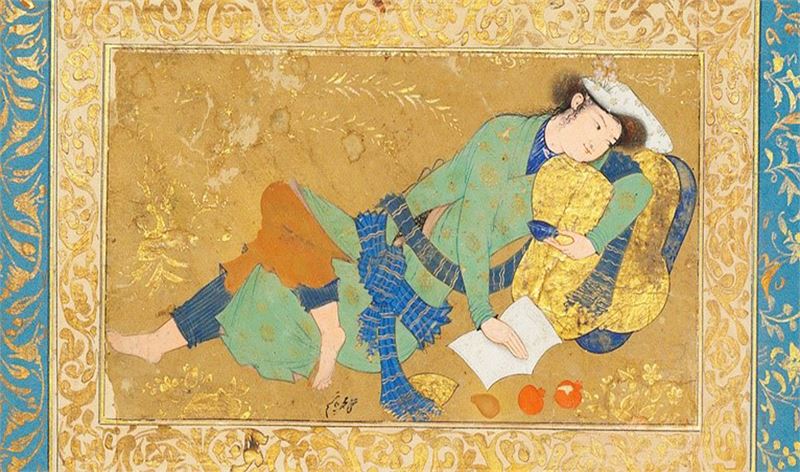
The artwork depicts a young girl holding a cup and a notebook, created in the 17th century using gouache, watercolor, and gold on paper. This miniature or painting is attributed to the esteemed artist Mohammad Qasim Mosavvar Tabrizi.
Persian painting underwent a notable revival in the 3rd century AH, corresponding to the 10th century AD, when Iranians successfully gained access to the Abbasid court. During this period, exquisite works of art were created; however, a considerable portion of these masterpieces was unfortunately lost during the Mongol invasions of Iran in the 7th and 8th centuries AH. In spite of this devastation, the establishment of the Rab'-e Rashidi in the city of Tabriz during the ilkhanate period in the 7th century AH marked a significant advancement in the realm of art. Workshops dedicated to the creation of manuscripts and their illustration were established in Rab'-e Rashidi, fostering the growth of numerous artists and scholars. During this era, remarkable works such as the Shahnameh of Ferdowsi and the Shahnameh of Abusa'idi were produced.
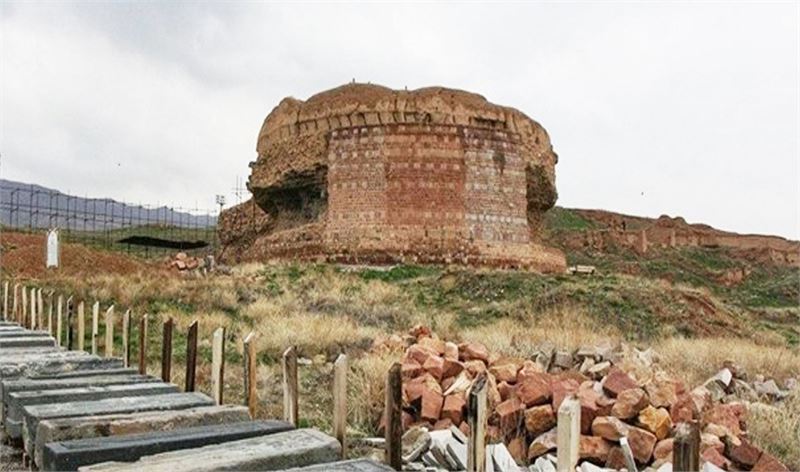
Rab'-e Rashidi is a historical complex located in Tabriz, Iran. It was stablished by Rashid al-Din Fazlollah Hamadani in the 7th century AH. It functioned as a university with four faculties situated at each corner, which is why it became known as "Rab'-e Rashidi" (literally "Quarter of Rashid"). This site was registered as a national monument of Iran in 1975.
In the mid-11th century AH, coinciding with the relocation of the capital from Qazvin to Isfahan, artists from Qazvin and other significant cities migrated to Isfahan. This led to a proliferation of painting and mural workshops aimed at decorating palaces and buildings. During the reign of Shah Abbas I, the expansion of political and commercial relations with European countries and India allowed certain characteristics and themes of western painting to influence Persian art. Over time, various schools of miniature "Negaargari" emerged, including the Isfahan, Herat, Qazvin, and Tabriz schools. Notable men of art such as Reza Abbasi, Afzal Hosseini, Shafi' Abbasi, Mohammad Yusef Mosavvar, and Mohammad Qasim Mosavvar Tabrizi rose to prominence during the Safavid period. Their creation of exquisite and unparalleled works marked the Safavid era as the pinnacle of Iranian miniature painting.
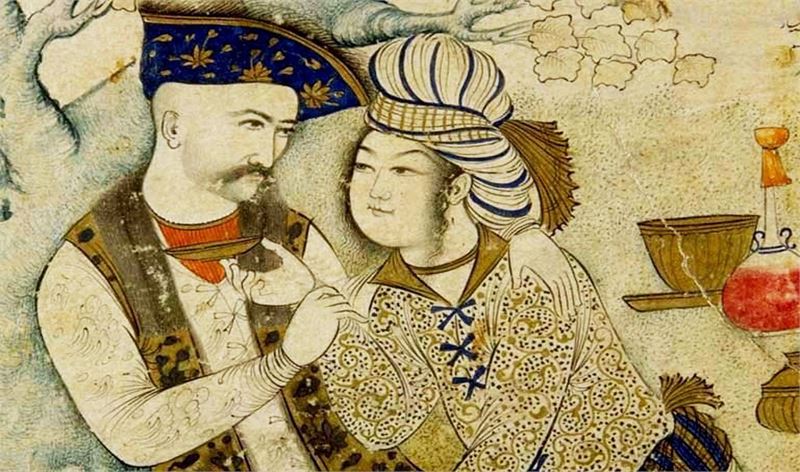
The miniature portrays Shah Abbas I of the Safavid dynasty alongside a young woman seated beneath a tree. This artwork was created by the esteemed man of art Mohammad Qasim Mosavvar Tabrizi in the year 1032 AH.
Mohammad Qasim Mosavvar Tabrizi was a renowned Safavid-era miniaturist, poet, and calligrapher of the 11th century AH (17th century CE). He was originally from Tabriz, and after mastering the fundamentals of illustration, he journeyed to Isfahan and placed himself under the tutelage of the esteemed and renowned masters of that region. His works and biographical accounts indicate that he was a contemporary of notable men of art such as Afzal Hosseini, Shafi' Abbasi, Mohammad Yusef Mosavvar, and Reza Abbasi. It is believed that Muhammad Qasim collaborated with Reza Abbasi in the creation of paintings for the Chehel Sotoon and Ali Qapu palaces in Isfahan, as evidenced by the striking similarities in their brushwork and compositional styles. Due to his proximity to the Safavid court, Mohammad Qasim had access to the most intimate royal gatherings and depicted many palace scenes. His paintings are characterized by a focus on mountains and landscape compositions. In portraying women and beauties, he favored tall, graceful figures with an alluring presence, utilizing chiaroscuro techniques. Notably, Mohammad Qasim was the first artist of the Safavid era to diverge from the conventional representation of clouds found in Iranian miniature, opting instead for a more naturalistic style influenced by European painting traditions. He adeptly incorporated new elements into Persian painting, adapting his work to align with the preferences of his patrons while also reflecting the impact of European artistic influences.
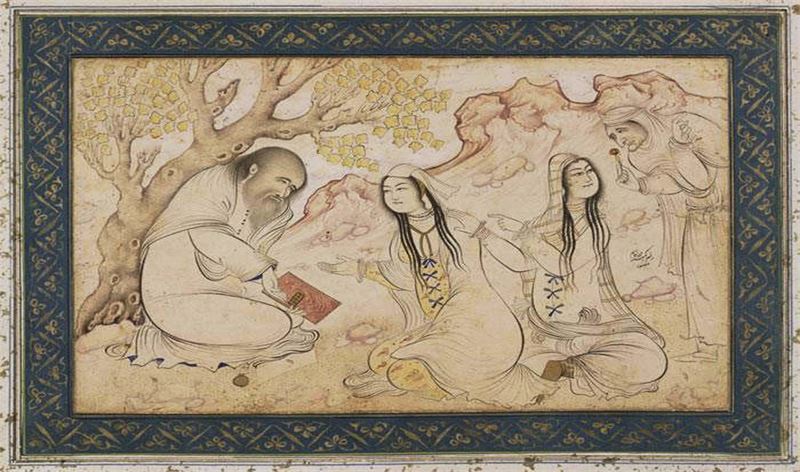
The miniature depicts a sheikh or dervish meeting with two young girls. This artwork was created by the prominent artist Mohammad Qasim Mosavvar Tabrizi in 989 AH. It reflects the everyday lives of young people during the Safavid era and their romantic adventures. Additionally, an elderly man positioned on the right offers a flower, presumably from a lover, for the girl to deliver to her beloved.
Historians of the Safavid period reference two eminent painters named Mohammad Qasim Mosavvar Tabrizi and Mohammad Qasim Mosavvar Serajay. Among the surviving artworks, only a few bear the signature of Mohammad Qasim Mosavvar Tabrizi, while others have been attributed to him by art historians. Most of Mohammad Qasim's works are housed in museums in Britain, the United States, Turkey, and France, with only one piece titled "Young Man with a Letter" located in the Golestan Palace Museum in Iran. His most renowned work, the Shahnameh of Qarajaghay Khan (Windsor Castle shahnameh), featuring 148 miniatures, is preserved in the Royal Collection at Windsor Castle in the United Kingdom.
This text is derived from an exclusive interview conducted by Mr. Akbar Karimi, an international reporter for the online newspaper Arirang Culture, with Mr. Iraj Bahmani, a researcher and graduate in Art History from Turkey.
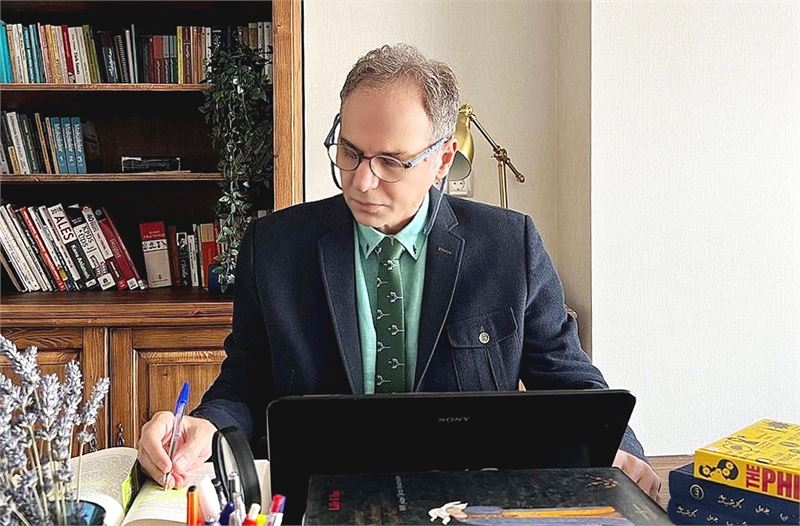
Mr. Iraj Bahmani was born in Tehran in 1968. In 1979, he moved to Zanjan with his family where he dedicated a significant amount of time acting in various theater productions and television series. As a graduate of Gazi University in Ankara, Turkey, with a degree in World History of Art, he authored his master's thesis titled "The Life and Works of the esteemed Muhammad Qasim-17th Century Miniaturist of the Safavid Era," a project that spanned over three years. Furthermore, he has undertaken extensive research on "Persian Carpet Designs" and "The Representation of Women in Safavid Miniatures".
---------------------
This article was contributed by Mr. Akbar Karimi, the international reporter for Arirang Culture Connect and the Founder and Managing Director of the Samte Ganjineye Ghoghnoos Cultural-Artistic Institute in Iran. His leadership in preserving and promoting Iranian intangible cultural heritage, along with his extensive experience in cultural-artistic research and his active participation in international forums such as UNESCO and ICCN, enriches his contributions to the global cultural dialogue.
Translated by Miss. Fereshte Abdi
Translation supervisor and director of international relations of Samte Ganjineye Ghoghnoos Institute: Mrs. Farnaz Seydi